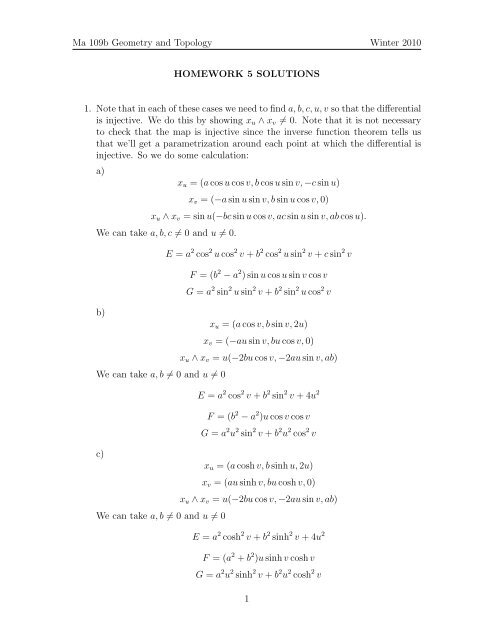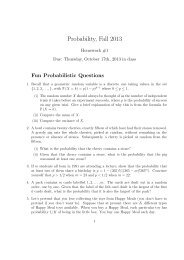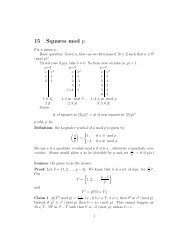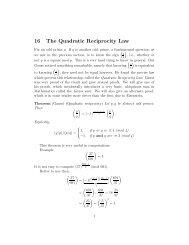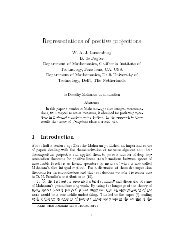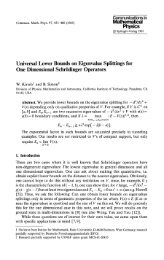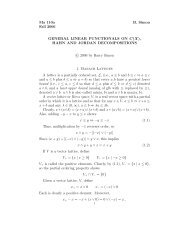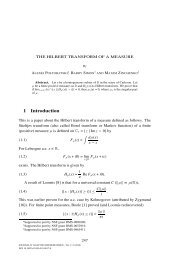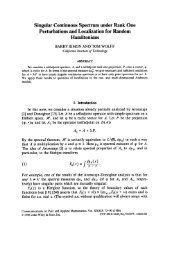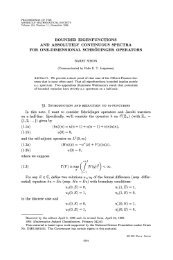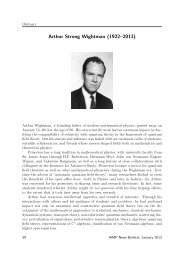Solutions to homework 5
Solutions to homework 5
Solutions to homework 5
You also want an ePaper? Increase the reach of your titles
YUMPU automatically turns print PDFs into web optimized ePapers that Google loves.
Ma 109b Geometry and Topology Winter 2010<br />
HOMEWORK 5 SOLUTIONS<br />
1. Note that in each of these cases we need <strong>to</strong> find a, b, c, u, v so that the differential<br />
is injective. We do this by showing xu ∧ xv = 0. Note that it is not necessary<br />
<strong>to</strong> check that the map is injective since the inverse function theorem tells us<br />
that we’ll get a parametrization around each point at which the differential is<br />
injective. So we do some calculation:<br />
a)<br />
xu = (a cos u cos v, b cos u sin v, −c sin u)<br />
xv = (−a sin u sin v, b sin u cos v, 0)<br />
xu ∧ xv = sin u(−bc sin u cos v, ac sin u sin v, ab cos u).<br />
We can take a, b, c = 0 and u = 0.<br />
b)<br />
We can take a, b = 0 and u = 0<br />
c)<br />
We can take a, b = 0 and u = 0<br />
E = a 2 cos 2 u cos 2 v + b 2 cos 2 u sin 2 v + c sin 2 v<br />
F = (b 2 − a 2 ) sin u cos u sin v cos v<br />
G = a 2 sin 2 u sin 2 v + b 2 sin 2 u cos 2 v<br />
xu = (a cos v, b sin v, 2u)<br />
xv = (−au sin v, bu cos v, 0)<br />
xu ∧ xv = u(−2bu cos v, −2au sin v, ab)<br />
E = a 2 cos 2 v + b 2 sin 2 v + 4u 2<br />
F = (b 2 − a 2 )u cos v cos v<br />
G = a 2 u 2 sin 2 v + b 2 u 2 cos 2 v<br />
xu = (a cosh v, b sinh u, 2u)<br />
xv = (au sinh v, bu cosh v, 0)<br />
xu ∧ xv = u(−2bu cos v, −2au sin v, ab)<br />
E = a 2 cosh 2 v + b 2 sinh 2 v + 4u 2<br />
F = (a 2 + b 2 )u sinh v cosh v<br />
G = a 2 u 2 sinh 2 v + b 2 u 2 cosh 2 v<br />
1
Ma 109b Geometry and Topology Winter 2010<br />
d)<br />
xu = (a cosh u cos v, b cosh u sin v, c sinh u)<br />
xv = (−a sinh u sin v, b sinh u, 0)<br />
xu ∧ xv = sinh u(−bc sinh u cos v, −ac sinh u sin v, ab cosh u)<br />
We can take a, b, c = 0 and u = 0.<br />
E = a 2 cosh 2 u cos 2 v + b cosh 2 sin 2 v + c 2 sinh 2 u<br />
F = (b 2 − a 2 ) sinh u cosh u sin v cos v<br />
G = a 2 sinh 2 u sin 2 v + b 2 sinh 2 u cos 2 v<br />
2. Assume that S1 is orientable and pick an atlas {(Ui, xi)} compatible with this<br />
orientation. So the change of coordinates between any neighborhoods must have<br />
positive determinant Then {(Ui, φ ◦ xi)} is an atlas for S2. We check that this<br />
induces an orientation. Indeed, for Ui, Uj such that φ ◦ xi(Ui) ∩ φ ◦ xj(Uj) = ⊘,<br />
the change of coordinates is<br />
hence has positive determinant.<br />
(φ ◦ xj) −1 ◦ (φ ◦ xi) = x −1<br />
j<br />
Since φ is a diffeomorphism the same argument works in the other direction.<br />
So we’ve shown that a diffeomorphism induces a choice of orientation, which<br />
implies that a surface is orientable iff any diffeomorphic surface is orientable.<br />
To show that a diffeomorphism can change orientation consider the plane parametrized<br />
by x(u, v) = (u, v, 0). Then the Jacobian of the diffeomorphism (u, v, 0) →<br />
(u, −v, 0) has negative determinant so it reverses orientation.<br />
3. We just need <strong>to</strong> check that (N ◦ α) ′ (t) is nonzero everywhere. But (N ◦ α) ′ (t) =<br />
dN(α ′ (t)), α ′ (t) is nonzero everywhere and dN is an invertible linear map away<br />
from planar and parabolic points.<br />
4. a) Write<br />
w1 = ae1 + be2<br />
w2 = ce1 + de2<br />
where e1, e2 are principal directions with corresponding <strong>to</strong> the principal curvatures<br />
k1, k2. Then with k1 = −k2 we have<br />
< dN(w1), dN(w2) >=< ak1e1+bk2e2, ck1e1+dk2e2 >= ack 2 1+bdk 2 2 = −k2k2 < w1, w2 > .<br />
2<br />
◦ xi
Ma 109b Geometry and Topology Winter 2010<br />
b) If v and w are the tangent vec<strong>to</strong>rs at p of two curves intersecting at p we<br />
have<br />
< dN(v), dN(w) ><br />
||dN(v)|| · ||dN(w)|| =<br />
=<br />
< dN(v), dN(w) ><br />
< dN(v), dN(v) > 1/2 · < dN(w), dN(w) > 1/2<br />
−K < v, w ><br />
√ −K < v, v > 1/2 · √ −K < dN(w), dN(w) > 1/2<br />
= < v, w ><br />
||v|| · ||w|| .<br />
5. a)Suppose that the tractrix is parametrized by (x(t), y(t)). The tangent line at<br />
(x(t), y(t)) is given in terms of (u, v) by<br />
u = x′ (t)<br />
y ′ (v − y(t)),<br />
(t)<br />
so we find that the (square of the) distance between (x(t), y(t)) and the xintercept<br />
of this line is<br />
1 = y(t) 2 ([ x′ (t)<br />
y ′ (t) ]2 + 1).<br />
We’ll assume that the curve is parametrized by arc length, that is y ′ (t) 2 +<br />
x ′ (t) 2 = 1 and simplify this <strong>to</strong><br />
So we can take<br />
for non-negative t.<br />
x(t) =<br />
y(t) 2 = y ′ (t) 2 .<br />
y(t) = e −t<br />
t<br />
0<br />
√ 1 − e −2t dt<br />
b) As in p.76 of do Carmo, the whole surface for t > 0 is regular.<br />
We can use as parametrizations<br />
for t > 0, 0 < θ < 2π and −π < θ < π.<br />
c) See do Carmo, p.161.<br />
(x(t), y(t) cos θ, y(t) sin θ)<br />
3


